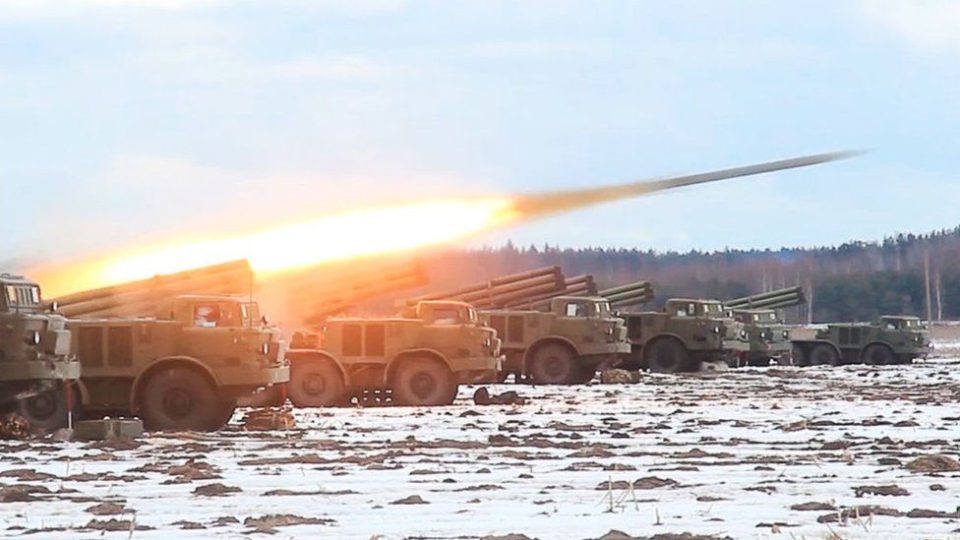
A look at Russian troop strength around Ukraine

Russia is sending thousands more troops to its border with Ukraine in a sign that the crisis on the eastern edges of Europe could extend for weeks.
Western intelligence and independent analysts estimate that a further 14 Russian battalions are heading towards Ukraine, each numbering about 800 troops, on top of the 100 battalions massed on the borders.
Despite the continued buildup of Russian forces in excess of 150,000, reports indicate war may yet be averted.
On Monday, Russian President Vladimir Putin invited his Foreign Minister, Sergei Lavrov, and Defence Minister, Sergei Shoigu, to the Kremlin for discussions.
“Sergei Viktorovich, what do you think? In your opinion, is there a chance to reach an agreement with our partners on the key questions causing our concerns?” Putin asked in a televised discussion.
“We have said more than once that we warn against endless conversations on issues that need to be resolved today,” said Lavrov. “But still, probably as the foreign minister, I should say that there is always a chance.” He advised Putin to continue holding talks with the West.
Shoigu, likewise, told the president that a number of military drills were “ending”, signalling that Russia could pull back some of its heavy weaponry soon. “Summary of Putin’s meeting with Shoigu: exercises are ending, everyone is going home, Russia will not have a new war with Ukraine,” one Kremlin pool reporter wrote after the meeting, according to a report.
Military Build-up
According to analysts, much of the build-up so far has involved troops and equipment that take time to deploy, including tanks and heavy armour, some of which have travelled by train from bases as far away as Siberia.
Around 100 Russian battalion tactical groups (BTGs) — fighting formations of 1,000 or so troops, accompanied by air defence, artillery and logistics — have been gathered on Ukraine’s borders with Russia and Belarus, according to Rochan Consulting, which tracks Russian military movements. These groups are now being joined by thousands more troops.
More TOS-1s on the way. https://t.co/WGWfpO30dL
— Konrad Muzyka – Rochan Consulting (@konrad_muzyka) February 13, 2022
The BTG is a fighting formation of 600 to 1,000 troops equipped with their own artillery, air defence and logistics.
During the 2015 war with Ukraine, Russia had sent no more than a dozen BTGs.
Ten out of Russia’s 11 Combined Arms Armies — a high-level formation that typically contains several divisions — are also now near Ukraine.
Also being put in position are Russia’s four naval fleets — the Baltic, Black Sea, Northern and Pacific Fleets. The defence ministry has said that it will be conducting drills involving more than 140 warships and support vessels and 10,000 personnel, including missile launches off Ireland’s west coast. Warships from Baltic and Northern Fleets have already been spotted moving towards the Black Sea. Key ships from the Pacific Fleet are also headed for the Mediterranean.
Engineering, logistics and medical facilities have also been spotted. Russian “pipeline troops”, which rapidly refuel mechanised forces, and can lay up to 80 kilometres of pipeline a day, have been seen in Krasnodar, close to Crimea. American officials have also said that Russia has moved blood supplies closer to the Ukrainian border, according to news agency Reuters.
Ukraine is essentially ringed on three sides, because of a large Russian military exercise in Belarus. ‘Allied Resolve’, a 10-day Russia-Belarus exercise, began on February 10. Moscow’s deployment into Belarus is believed to be its biggest there since the Cold War, with “an expected 30,000 combat troops, Spetsnaz special operation forces, fighter jets including SU-35, Iskander dual-capable missiles and S-400 air defence systems,” NATO Secretary General Jens Stoltenberg said on February 3.
Past Build-ups
Although the Soviet Union did send in a quarter of a million troops when it and its Warsaw Pact allies invaded Czechoslovakia in 1968, with ten more divisions in the rear, the current build-up is not far from the biggest Soviet exercise ever held during the Cold War.
‘Zapad-81’ in 1981 involved as many as 150,000 troops, and the present situation has already surpassed the biggest NATO exercise, ‘Reforger’, in 1988, which gathered 125,000. Russia’s build-up today is also larger than America’s in Europe ahead of the first Gulf War in 1991 or the NATO air campaign against Serbia in 1999. It also goes past the first and second Chechen wars, which began in 1994 and 1999, respectively, each of which involved fewer than 50,000 Russian troops.


